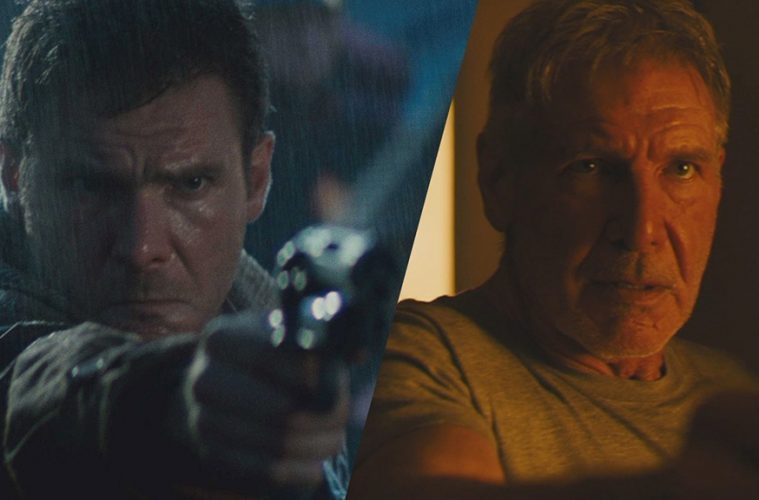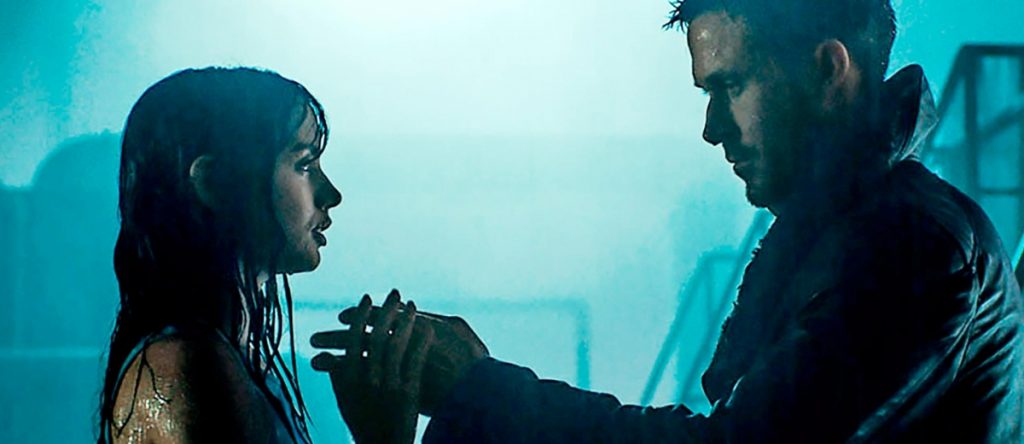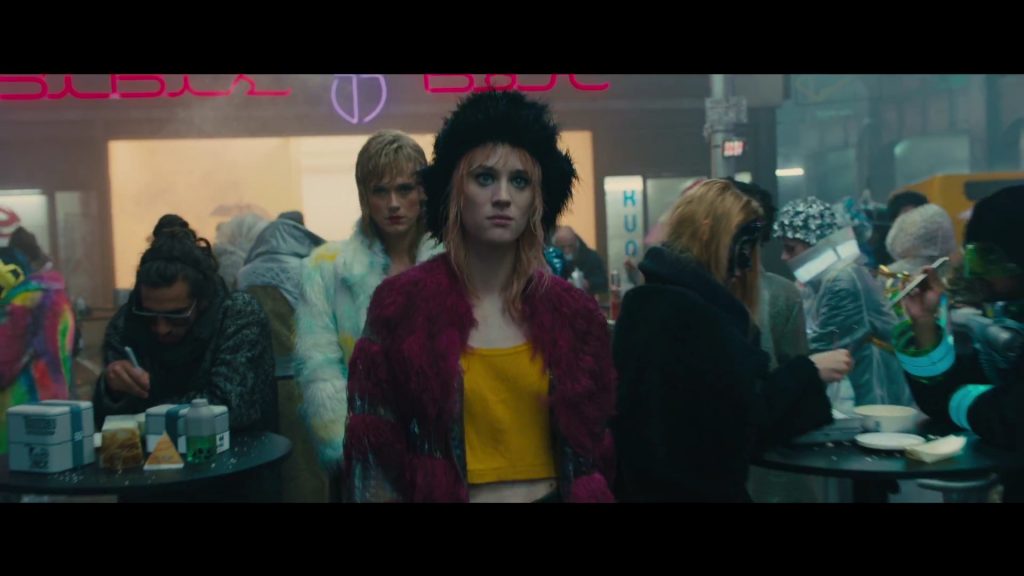“If you have two X chromosomes, or know and like someone who does, “Blade Runner 2049” may not be the movie for you.” the New York Post states in their review of Blade Runner 2049. They are not alone, since its release the sequel to the 1982 science fiction masterpiece has attracted a fair bit of criticism for its treatment of female characters. Blade Runner also attracted its share of disapproval for its portrayal of women, in particular for the death scenes of replicants Zhora and Pris, and for the somewhat rapey love scene between Rick Deckard and Rachael.
So are the Blade Runner movies sexist? The future that the movies portray certainly is, a technologically advanced but equally decrepit dystopia in which bioengineered synthetic humans (known as replicants) are manufactured for use as slaves. Replicants are given the tasks that are considered dangerous, menial, or degrading for ‘real’ humans. In the case of female replicants they are often created as ‘pleasure models’ a prosaic way of saying sex slaves. Replicant women are objectified, in that they are quite literally considered to be objects, playthings designed and manufactured to give pleasure to those around them.
Critics may have condemned both Blade Runner movies for their handling of female characters, but I think that in order to fully understand those depictions it helps to have some knowledge of the cinematic tradition that these movies directly homage. Both Blade Runner and Blade Runner 2049 are considered to be Neo-Noir, this means that they make use of the tropes and conventions of Film Noir.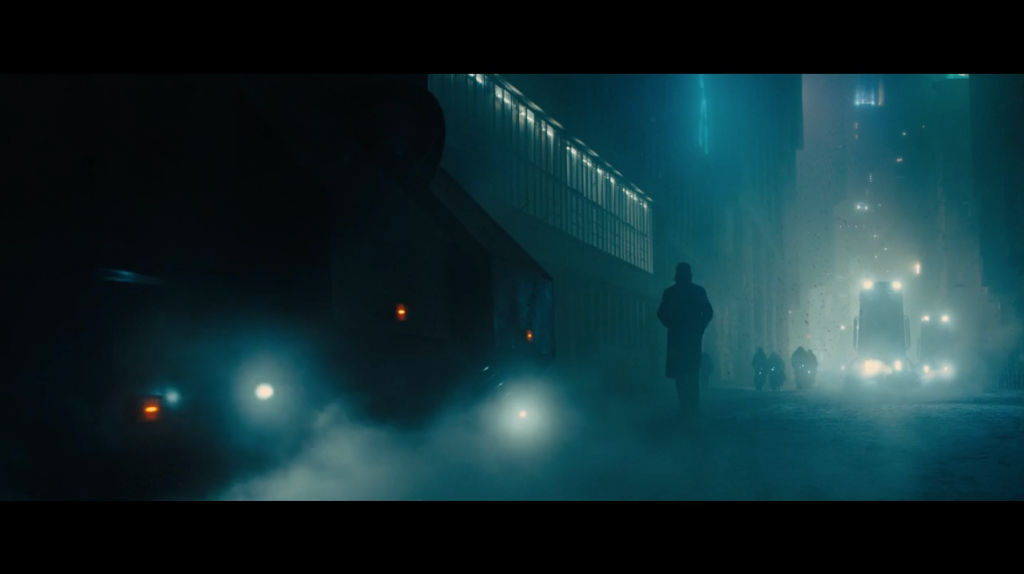
Film Noir, which means quite literally ‘black film’, is a phrase that was first used in 1946 by French film critic Nino Frank to describe a particular style of crime drama produced by Hollywood between the early 1940s and the late 1950s. Examples include The Maltese Falcon, The Third Man, Out Of The Past, and The Big Sleep. Noir movies grew from the popular hard-boiled detective stories of the 1930s, a phase that saw elite, heroic, upper crust investigators replaced with grittier, uncompromising, working-class anti-heroes. The stories were harsher, more violent, and the protagonists often had weaknesses and a moral ambiguity that made them less than exemplary role models. Looking at the historical context it’s hardly surprising, America had just come out of two world wars and The Great Depression. This was a wounded nation, its people disillusioned with the traditional literary heroic ideal. As a style, Film Noir was directly influenced by the aesthetics of German expressionism, which were typically characterised by distortion and overemphasis. Another inspiration was French poetic realism, a cinematic style based on stylised and highly aesthetic realism, in which common themes are disillusionment and fatalism. This influence meant that these themes are often found in Film Noir as well. The ideas of German expressionism and French poetic realism were brought to Hollywood by European filmmakers that fled to America in prewar years.
Film Noir movies use several techniques to give a specific aesthetic, and to convey theme. Low-key lighting, night, shadow, rain, and smoke, are used to distort the environment, and make the characters seem less glamorous. Use of night and shadow convey the cold and hopeless mood that permeates Film Noir narrative. Cinematography in Film Noir is composed of wide angle shots and vertical, slanting lines, designed to disorient the viewer. These visual conventions serve to convey themes of disquiet, rejection, and isolation.
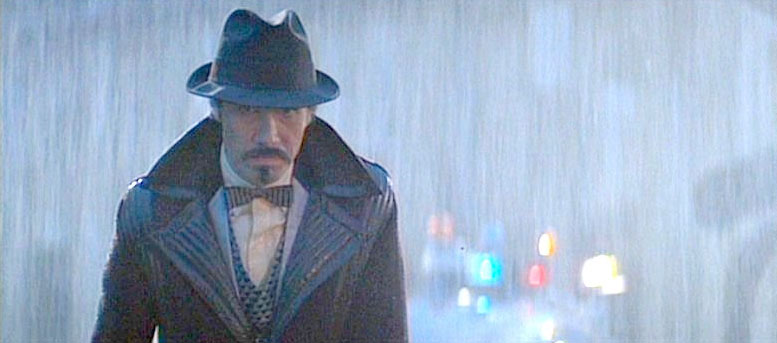
But it isn’t just the look that makes Film Noir so distinctive. As a style, Film Noir also makes use of disjointed narrative methods, particularly flashbacks and voice over narration, as well as very specific character archetypes. Male protagonists are usually outcasts, living on the fringe of society and working within its underbelly in roles such as private detectives (or Blade Runners) They can be tough, but lack social skills and are often somewhat ineffectual within the power structures that control the world around them. In Blade Runner, Rick Deckard is blunt, awkward, and unlikable. He drinks almost constantly, has difficulty making conversation, and struggles to connect with others. This is particularly apparent in his conversation with Rachael where he explains that she is a replicant, and that her memories were implanted. Deckard delivers the truth of her existence without tact or subtlety. He only realises how upsetting this is to Rachael when she begins to cry, after which he unconvincingly backtracks.
Deckard is not a cool or invincible hero, he has questionable moral judgement and little power in the space around him. His former boss forces him to come out of retirement by threatening him, and he gets his ass handed to him several times throughout the movie. Even the Japanese restaurant guy argues with Deckard about his food order, and wins. The two biggest examples of Deckard’s inadequacy are in the love scene with Rachael, in which he awkwardly and unromantically comes on to her before forcing her to submit to his attentions, and the final battle with Roy Batty, which Deckard LOSES. The only reason Deckard survives is that Batty chooses to save him from falling to his death, before summarising the tragedy of mortality with the ‘tears in rain’ monologue.
In Blade Runner 2049 the social ostracism of the male protagonist is even more pronounced since K, Blade Runner and central character of the movie, is himself a replicant. A replicant uprising caused the manufacture and sale of replicants to become illegal for a time, and so the newer generations of replicants are tightly controlled and created to obey. K has the task of hunting down and ‘retiring’ older model replicants who slipped the net, meaning that he is disliked and distrusted by other replicants. K also has limited social skills and cannot form attachments, mainly because as a replicant he is seen by humans as little more than a tool (or a danger) and the restricted free will he was created with means that he is unable to meet humans on equal terms.
Female characters in Film Noir are also archetypal, consisting of two distinct tropes, the Madonna and the Whore. The femme-fatale that is traditionally associated with Film Noir is an example of the Whore, a woman who is characterised as dangerous, untrustworthy, and darkly sexual. The Madonna is characterised as a ‘good woman’, meaning a woman who embraces her traditional place within society i.e as wife or mother. The context for this historically relates to the massive increase of women in the workplace that occurred as a result of World War II, and American social angst at having to rethink and adjust ideas of traditional gender roles.
Traditional Western values regarding the nuclear family play a large part in Film Noir, but only as far as to serve as an appropriate contrast to the themes of rejection and isolation. These are underworld movies, and the characters exist outside of the socially accepted and idealised structures of family or marriage. The superficial view of Film Noir in terms of women, family and gender roles is that it supports a rather conservative perspective, that those who reject their place within long-established conventional roles are a threat to the moral fabric of society. The maintenance of the status quo requires that these people, whether it be the dangerously independent femme-fatale or the weak and morally ambiguous man who falls for her charms, must be punished and/or destroyed.
Blade Runner has three main female roles, those of Rachael, Zhora, and Pris. Upon first meeting Rachael Deckard is immediately drawn to her, but her status as a replicant means that she is untrustworthy, and possibly dangerous. This would usually put her within the bracket of femme-fatale, and it’s clear that her 1940s-style hair and costume is designed to give that impression. However, Rachael is actually a subversion of the femme-fatale trope. She is for the most part subservient, first to Tyrell and then to Deckard. Pris and Zhora are also replicants, the former made as a pleasure model and the latter as an assassin. Both are independent, strong, and freely use their sexuality as a weapon, Zhora to distract Deckard and Pris to trick J.F. Sebastian into allowing her into his home. Zhora and Pris for the most part act independently, are self-reliant, and refuse to accept their designated place. It seems that for this they are punished, both destroyed by Deckard, while the submissive and pliant Rachael is the one who gets to live.
The cursory interpretation of Film Noir may indicate regressive values, but scratch the surface and what is lurking beneath is far more complex. While Film Noir may outwardly seem to endorse the nuclear family unit, there is an equally strong undercurrent that is anti-family. Traditional societal roles are rarely portrayed positively in Film Noir, family relationships are usually twisted and perverted, while traditional marriage is shown as boring and sexually unfulfilling. The femme-fatale is keen to avoid the traps of the traditional feminine roles of wife and mother, and will use violence, cunning, and sexual whiles to win or retain her independence. The ‘good woman’ serves the status quo, she is nurturing, submissive, and compliant. Her world is clean and pure, her physical surroundings free of the negative mise-en-scene that permeates the environment of the protagonist and the femme-fatale. She is also a fantasy, an unattainable illusion that the protagonist cannot reach or hold on to. Film Noir contains a degree of fatalism, the protagonist sets himself on a destined and unavoidable path to self-destruction. The ‘good woman’, the virtuous and socially acceptable choice, is not enough to pull him away from the path of disaster and towards the happy ending. This suggests that ultimately, traditional societal roles are no refuge for anyone. The other point is that even though the femme-fatale is destroyed as ‘punishment’ for her refusal to submit, it is she that garners the most emotional investment from the viewer.
Rachael may be the ‘good woman’ in the world of Blade Runner, but she is a replicant. She was artificially created, her memories are not really hers, and her life span is indeterminate. She and Deckard (as becomes clear in Blade Runner 2049) spend of the rest of their lives hunted and in fear of their lives. In Blade Runner 2049 the fantasy ‘good woman’ is literal, in that the love interest of K is a holographic artificial intelligence program named Joi. She is designed to be exactly what her owner wishes her to be, and yet she has no physical presence or personality beyond the superficial. She is there, and clearly very much desired by K, but she remains just out of reach. Ultimately her relationship with K is a shadow of an idealised love story between an incomplete computer program, and an incomplete man.
 What critics seem to miss is that it is the female characters in Film Noir that serve as the largest component in expressing mistrust in the nuclear family. The Blade Runner movies have the added dimension that they are Neo-Noir Cyberpunk, incorporating other elements and influences than just Film Noir. Blade Runner is set in a dystopian future, and therefore must be viewed in the context of that dystopia. Critics complain at being discomforted by the way in which the Blade Runner movies portray women, the violence committed against them, and their disposability. However, all replicants are created to be slaves, their bodies completely without agency, their lives expendable. That is SUPPOSED to make the viewer uncomfortable, since we’re supposed to question how replicants are really any different from ‘real’ humans.
What critics seem to miss is that it is the female characters in Film Noir that serve as the largest component in expressing mistrust in the nuclear family. The Blade Runner movies have the added dimension that they are Neo-Noir Cyberpunk, incorporating other elements and influences than just Film Noir. Blade Runner is set in a dystopian future, and therefore must be viewed in the context of that dystopia. Critics complain at being discomforted by the way in which the Blade Runner movies portray women, the violence committed against them, and their disposability. However, all replicants are created to be slaves, their bodies completely without agency, their lives expendable. That is SUPPOSED to make the viewer uncomfortable, since we’re supposed to question how replicants are really any different from ‘real’ humans.
The real problem that critics appears to have is that while both Blade Runner movies remain true to the stylistic and narrative concepts of Film Noir, neither or them make any kind of value judgement on them. To me this indicates laziness as a critic, and a kind of illiteracy regarding film analysis and context. The concept of independent women being destroyed for disobedience comes directly from Film Noir, but the point of the setting is that ANYONE who rejects their designated place within society, regardless of gender, is systematically destroyed. The Blade Runner movies use elements of Film Noir, in particular the concept of focusing on characters who are ostracised from the masses, and ineffectual within the establishment. They don’t challenge the systems within them, but isn’t that the point? Everybody else within that universe is happy with the status quo, and will fight to protect it.
Like a lot of sci-fi both Blade Runner movies ask questions about the nature of human existence, however, you have to decide for yourselves on the answers. Film Noir movies are somewhat notorious for their lack of happy endings, and there is no Captain Planet moral at the end of the story. You are free to make your own judgements. The lamenting by critics about the lack of progressive moralising within these movies makes me uneasy. It seems like an attempt to take us back to the days of The Hays Code, a set of guidelines from between the 1930s and 1960s that demanded that Hollywood movies reflect and maintain moral standards.
The Hays Code was based on the principle that “if motion pictures present stories that will affect lives for the better, they can become the most powerful force for the improvement of mankind” Movies that didn’t obey The Hays Code were heavily censored. The idea of film critics as moral arbiters of what subjects films are allowed to portray, and whether or not we can enjoy them based on arbitrary identity characteristics, is both ridiculous and disturbing. Particularly as few of these critics seem to know very much about the subject that they are critiquing.
Blade Runner 2049 has had a rocky start, with disappointing box office sales in relation to its massive budget. This is a shame, since although it is a completely unnecessary sequel to one of the greatest sci-fi movies ever made it is better than is has any right to be. The visuals are magnificent and the score is excellent. There are some fantastic performances, particularly from Dave Bautista, but Jared Leto’s villain, Wallace, is far more intimidating off screen then when he is on it. The pacing is slow, no doubt as a callback to the original Blade Runner and a chance for the viewer to enjoy some of the gorgeous cinematography. However, I’d personally say that the movie is slightly overlong, and somewhat bloated.
There are some interesting ideas, that main one being that Deckard DIDN’T manage to drink himself to death in the thirty years between the first movie and the second, but there isn’t really a standout ‘tears in rain’ moment that will stay with you long after watching. Blade Runner 2049 is enjoyable, and does expand the lore of the setting, which is the best you can really hope for a sequel made so long after the original movie. However, it also commits the cardinal sin of breaking established rules for purposes of plot convenience. Replicants cannot disobey, except when they can. Replicants cannot lie, except when they do. Would Blade Runner 2049 have been a better movies without the archetypes? Or with a more modern and progressive style of filmmaking and narrative? Perhaps. But it was designed to be a sequel to a Film Noir movie, and ultimately? There’s only so much you can change a concept before it stops being what it’s supposed to be.

